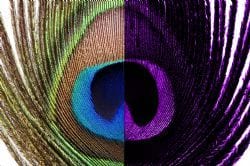Scientists from the University of Lincoln are presenting their research into colour vision in animals at the Royal Society’s annual Summer Science Exhibition, which opens today (3 July 2012).
Animal colouration provides some of the most striking examples of evolution by natural and sexual selection. However, animal colours did not evolve for our benefit; the impressive array of animal colours that we see (and can’t see) in the natural world allows animals to communicate with each other, to attract mates and to avoid predators.
The exhibit from the University of Lincoln explains the evolution and diversity of animal colouration, including ‘hidden’ colours that are invisible to humans, by considering how these colours appear to those who matter most: the animals themselves.
Dr Tom Pike, Senior Lecturer from the University’s School of Life Sciences, said: “We rely overwhelmingly on colour vision in our everyday lives, and tend to assume that what we see represents the limits of the visual world. However, colour vision in animals, and their resultant perception of the visual world, often differs considerably from our own. Many, for example, can see ultraviolet light, some can see polarised light, and a good number can see many more colours than we can. Having said that, certain animals see far fewer colours than us – something that anyone who is colour blind can sympathise with.
“Because animal colours evolved for the benefit of animal – and not human – eyes, understanding the visual world from an animal’s point of view can explain why some animals are bright while others are dull. Some are highly patterned and others plain. This allows us not only to shed exciting new light on the animal colours we can see, but also to understand the importance of colours that we can’t.”The Lincoln scientists will be on hand at the exhibition which runs from 3 July to 8 July, to talk visitors through their research.
The Royal Society Summer Science Exhibition showcases cutting edge research in science and engineering from across the UK. It is held annually at the Royal Society, the UK’s national academy of science.
— Story Credits —Ian Richards – Communications Officer – Press & Media
E-mail: irichards@lincoln.ac.uk
Telephone: 01522 886042
Royal Society exhibition puts focus on Lincoln’s animal vision research
- Superbug which attacks wounded soldiers could be combated by ‘friendly’ viruses
- AHRC launches international blog


